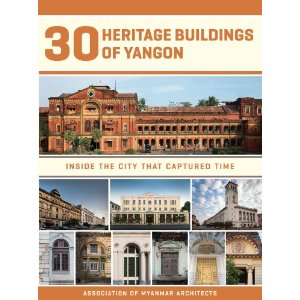30 Heritage Buildings of Yangon: Inside the City That Captured Time
Posted: October 25th, 2012 | No Comments »With Burma so front and centre in people’s minds in Asia at the moment I’ve posted occasionally on Burma-related things. Sarah Rooney’s 30 Heritage Buildings of Yangon (Rangoon) has been recommended to me and looks lush and lovely and the perfect little item for my coffee table right now…blurb and cover below as ever (and a link to the new Irrawaddy Literary Festival that deserves a plug too):
This book focuses on a selection of 30 key buildings and examines their past, present, and future. Piecing together the often forgotten social history of each building has involved delving into out-of-print books, company records, old city directories, newspaper archives, and people s memories. Published in both Burmese and English language editions, this book aims to contribute to the collective conversation about the social and economic potential of Yangon s colonial-era heritage in the hope that the city s architectural past can become a vibrant and sustainable part of its future. The modern history of Yangon can be traced through its colonial-era architecture. From the monumental former Reserve Bank of India, which records every step of the country s fiscal history, to the now derelict Pegu Club, which was once the favoured watering hole for officers of the British colonial government, each building has a story to tell. The buildings have survived war, natural disaster, and numerous changes of ownership. Many have been repurposed over the years. Today, the biggest threat to these buildings is neglect and lack of protection. In recent years they have become increasingly vulnerable. In 2005, when the government moved to the new capital of Naypyidaw, it abandoned many of its ministerial offices or left them only partially in use. Many were also badly damaged during Cyclone Nargis in 2008. As the country opens up to new investment and tourism, the buildings are in danger of falling prey to property developers as most occupy prime plots of land in the city centre. This book focuses on a selection of 30 key buildings and examines their past, present, and future.

Leave a Reply